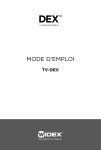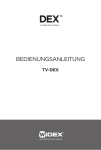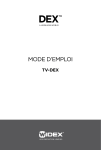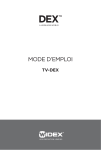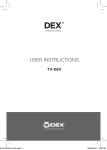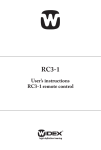Download Widex TV-Dex User manual
Transcript
User instructions TV-Dex 2 Contents Package Contents . . . . . . . . . . . . . . . . . . . . . . . . . . . . . . . . . . 4 Your new TV-Dex . . . . . . . . . . . . . . . . . . . . . . . . . . . . . . . . . . . . 5 TV-Controller . . . . . . . . . . . . . . . . . . . . . . . . . . . . . . . . . . . . . 6 TV-Base . . . . . . . . . . . . . . . . . . . . . . . . . . . . . . . . . . . . . . . . . . . . . . 7 Light-emitting diodes . . . . . . . . . . . . . . . . . . . . . . . . . . . . . . . . 8 Getting started . . . . . . . . . . . . . . . . . . . . . . . . . . . . . . . . . . . . 9 Connecting the units: . . . . . . . . . . . . . . . . . . . . . . . . . . . . . 9 When using more than one tv-base . . . . . . . . . . . . . . . 14 Usage . . . . . . . . . . . . . . . . . . . . . . . . . . . . . . . . . . . . . . . . . . . . . . 15 Transmission . . . . . . . . . . . . . . . . . . . . . . . . . . . . . . . . . . . . . . 17 Adjusting the volume . . . . . . . . . . . . . . . . . . . . . . . . . . . . . 19 Mute . . . . . . . . . . . . . . . . . . . . . . . . . . . . . . . . . . . . . . . . . . . . . . . 19 Room off . . . . . . . . . . . . . . . . . . . . . . . . . . . . . . . . . . . . . . . . . . 19 Recharging the battery . . . . . . . . . . . . . . . . . . . . . . . . . . 20 Troubleshooting . . . . . . . . . . . . . . . . . . . . . . . . . . . . . . . . . . . 21 Caring tips and warnings . . . . . . . . . . . . . . . . . . . . . . . . . . 23 Safety Warning . . . . . . . . . . . . . . . . . . . . . . . . . . . . . . . . . . . 25 Regulatory information . . . . . . . . . . . . . . . . . . . . . . . . . . 26 3 Package Contents User manual TV-Controller Box 1: Mini USB power supply Box 2: Lanyard Box 3: a. 3.5 mm jack to 3.5 mm jack cable b. 3.5 mm jack to phono cable Box 4: a.TV-Base b. SCART adaptor 4 a. b. a. b. Your new TV-Dex We hope you will be pleased with your DEX™ TVController and TV-Base. These user instructions explain how these units should be operated. Please read this booklet carefully before you start using the units. 1.TV-Controller 2.TV-Base 1. 2. 5 TV-Controller The controller is provided with four keys: 1.Transmission on/off 2.Room off 3.Volume up 4.Volume down 1. 3. 4. 2. 6 TV-Base On the back of the base you will find the following inputs: 1.Power 2.TV 3.Audio 1. 2. 3. On the underside of the base there is a switch with a choice of two settings: 1.HEARING AID 2.HEARING AIDS 1. 1. Monaural/binaural switch The setting chosen by your hearing care professional depends on whether you use a hearing aid in only one ear (monaural) or in both ears (binaural). 7 Light-emitting diodes There are two light-emitting diodes (LEDs) on the controller. 1.Constant green light: Transmission 2.Changing from green to red: Transmission off 3.Constant red light: Room off active 4.Flashing red and green light: Battery charging 2. 1. 4. 3. 8 Getting started You can skip steps 5+6 if you only wish to transmit from the TV, and steps 3+4 if you only wish to transmit from an audio source. Connecting the units: 1. Connect the mini-USB power supply unit to the base. (The supply unit is available in four versions. Your supply may therefore not look exactly as illustrated). 2. Plug the other end into a wall socket. POWER TV 1. 2. 9 AUDIO 3a. Connect the jack to phono cable to the base. 4a. Plug the two phono connectors at the other end of the cable into AUDIO OUT on the TV. Please refer to the user guide for your TV for further details. POWER TV AUDIO 3a. 4a. 10 If the TV has no AUDIO OUT, a SCART adaptor should be used: 3b. Connect the phono connectors to the two terminals on the included SCART adaptor (red to red and white to white). 4b.Plug the SCART adaptor into the TV´s SCART socket. 4b. 3b. 11 5. Plug the jack to jack cable into the audio input on the base. 6. Connect the other end to the audio source (e.g. a stereo system). POWER TV AUDIO 6. 5. 12 7. Place the controller in the base and allow it to charge for eight hours (the first time). 13 When using more than one tv-base If you only have one base, this base is automatically selected the first time you charge the controller in the base. If you have more than one base, you can change between these by placing the controller in the base you wish to use for approx. 5 seconds. 14 Usage Up to 1.0 m We recommend that you hang the controller around your neck when in use, on the lanyard provided. Up to 10 m 15 Place the controller in the plastic holder at the end of the lanyard as illustrated. The breakaway buckle of the lanyard must be positioned at the back of your neck (1). 16 Transmission With either TV or audio connected • Press the transmission on/off key on the controller once to start transmitting from the connected source. An acoustic signal will sound in your hearing aids, and the transmission LED will turn green. • Press the key again once to stop transmission. The hearing aids will enter the Master program as indicated by a voice message or beep tones. The green LED will change briefly to red and then off. With both TV and audio connected: • Press the transmission on/off key on the controller once to start transmission from the TV. An acoustic signal will sound in your hearing aids, and the transmission LED will turn green. • Press the key a second time to transmit sound from the audio source instead. An acoustic signal will sound in your hearing aids. • Press the key a third time to stop transmission. The hearing aids will enter the Master program, as indicated by a voice message or beep tones. The green LED will change briefly to red and then off. 17 If you carry your controller around with you and move outside the operating range, transmission will be interrupted and your hearing aids will switch to the Master program. The LED will flash at slow intervals to indicate that transmission has been interrupted. The change will be indicated by a voice message. If your hearing aids are set up with beeptone indication instead, no acoustic indication will sound. If you come in range again, the controller will detect the signal from the TV/Audio and restart transmission. A sound will be heard in the hearing aids. The LED will light constantly rather than flash. Note that the LED may continue to be red if you chose to turn off the hearing aid microphones during transmission. 18 Adjusting the volume Press the volume up key to raise the volume of the transmitted TV or audio sound. Press the volume down key to lower the volume. UP DOWN Mute You can mute the transmitted TV or audio sound on the TV or audio source. Room off If you wish to turn the hearing aid microphones off during transmission, so that you only hear the transmitted sound, press the room on/off key once. To turn the microphones back on, press again. An acoustic indicator will sound in your hearing aids, and the red LED will turn off. 19 Recharging the battery The controller uses a rechargeable battery. When fully charged, the battery has a capacity of approx. 10 hours of transmission, decreasing over time. When the battery runs low, transmission is interrupted. To recharge the battery, place the controller in the base for approximately 4 hours. You can also recharge the battery using an appropriate USB power supply supplied by Widex. Contact your hearing care professional if the battery needs replacement. 20 Troubleshooting Problem Potential cause Your TVThe battery is Controller exhausted does not work Base has not been selected The green diode on the TV-Controller turns on for a brief period of time and then turns off No transmitted sound even if the green diode is turned on Solution Charge the battery Place the TVController in the TV-Base for at least 5 seconds The battery needs replacement Contact your hearing care professional The jack plug for tv or audio connection is not connected to the TV-Base Connect the jack plug as shown on page 10/12 The TV-Base is not connected to the electrical mains Connect the TV-Base as described on page 9 TV/audio source is not switched on Switch TV/audio source on Sound source and TV-Base are not properly connected Connect the sound source and TV-Base as shown on pages 10,11,12 21 Problem Potential cause Transmission interrupted TV-Controller battery Charge the TVis exhausted Controller When transmitting, parts of the sound image from the TV/audio source are missing Solution TV-Controller is out of operating range Move within operating range Monaural/binaural switch on the underside of the TV-Base is not set correctly Check that the switch is in the correct position. See page 6. Volume of TV-Base is not transmitted connected to the sound correct output changes when you adjust the volume of the sound source 22 Connect the TV-Base to the correct TV/ audio output. Please refer to the user instructions for the TV/audio source. Caring tips and warnings • The TV-DEX units are valuable objects and should be treated with care. • Do not expose your TV-DEX units to extreme temperatures or high humidity. • Never try to open or repair the TV-DEX units yourself. (This should only be done by authorised personnel.) • Clean the units with a soft cloth. Never wash them with water, cleaning solutions or other liquids. • Do not carry the TV-DEX units with you during Xrays, scans or radiation treatments and never place them in a microwave oven. These are some of the types of radiation that can damage the units. However, radiation from, for example, room surveillance equipment, burglar alarms or mobile phones is weaker and will not damage your TVDEX units. • Keep your TV-DEX units and their parts and accessories out of reach of children and anyone else who might swallow parts of the devices, or otherwise cause injury to themselves with these items. In case of ingestion, contact a physician immediately. • Do not use the TV-DEX units on aircraft or in hospitals without permission. 23 • Do not use the TV-DEX units in mines or other areas with explosive gases. • Although the TV-DEX units have been designed to comply with the most stringent international electromagnetic compatibility standards, the possibility cannot be excluded that they may cause interference with other equipment, such as medical devices. • If you wear your TV-Controller around your neck, make sure that the breakaway buckle on the lanyard is always at the back of your neck. • TV-DEX units are made of modern non-allergenic materials. Nonetheless, in rare cases skin irritation may occur. If you notice such skin irritation, contact your hearing care professional. 24 Safety Warning This device is powered by an external power supply. • Only connect a power supply that is compatible with the TV-DEX. • The power supply must have an output rating of 5VDC, 500mA and mini USB connector. • The power supply input rating voltage must match the mains power voltage in your region and the power supply must have a mains male plug that is compatible with the AC wall socket in your region • The power supply must be designed for ITE and must have the certification marks showing certification by an agency acceptable in your region. Widex strongly recommends that you always use a power supply that is delivered by your Widex Distributor to ensure safe and efficient use of your TVDEX. 25 Regulatory information Hereby, Widex A/S declares that this TV-Controller and TV-Base are in compliance with the essential requirements and other relevant provisions of Directive 1999/5/EC. A copy of the Declaration of Conformity can be found at: http://www.widex.com 26 Federal Communications Commission and Industry Canada Statement FCC ID: TTY-TVB FCC ID: TTY-TVC IC: 5676B-TVB IC: 5676B-TVC This device complies with part 15 of the FCC Rules and with RSS-210 of Industry Canada. Operation is subject to the following two conditions: (1) This device may not cause harmful interference, and (2) this device must accept any interference received, including interference that may cause undesired operation. NOTE: This equipment has been tested and found to comply with the limits for a Class B digital device, pursuant to part 15 of the FCC Rules. These limits are designed to provide reasonable protection against harmful interference in a residential installation. This equipment generates, uses and can radiate radio frequency energy and, if not installed and used in accordance with the instructions, may cause harmful interference to radio communications. However, there is no guarantee that interference will not occur in a particular installation. If this equipment does cause harmful interference to radio or television reception, which can be determined by turning the equipment off and on, the user is 27 encouraged to try to correct the interference by one or more of the following measures: – Reorient or relocate the receiving antenna. – Increase the separation between the equipment and receiver. – Connect the equipment into an outlet on a circuit different from that to which the receiver is connected. – Consult the dealer or an experienced radio/TV technician for help. NOTE: This equipment complies with FCC radiation exposure limits set forth for an uncontrolled environment. This transmitter must not be co-located or operating in conjunction with any other antenna or transmitter. This equipment complies with the Industry Canada RF radiation exposure limits set forth for an uncontrolled environment as per IC RSS-102 Issue 3. Changes or modifications to the equipment not expressly approved by Widex could void the user’s authority to operate the equipment. 28 Electrical and electronic equipment (EEE) contains materials, components and substances that can be hazardous and present a risk to human health and the environment when waste electrical and electronic equipment (WEEE) is not handled correctly. Do not dispose of hearing aids, hearing aid accessories and batteries with ordinary household waste. Hearing aids, batteries and hearing aid accessories should be disposed of at sites intended for waste electrical and electronic equipment, or given to your hearing care professional for safe disposal. Proper disposal helps to protect human health and the environment. 29 Symbols sYmBols symbols commonly used by widex a/s in medical device labelling (labels/ifu/etc .) symbol title/Description manufacturer the product is produced by the manufacturer whose name and address are stated next to the symbol . if appropriate, the date of manufacture may also be stated . Date of manufacture the date when the product was manufactured . use-by date the date after which the product is not to be used . Batch code the product’s batch code (lot or batch identification) . catalogue number the product’s catalogue (item) number . serial number the product’s serial number .* keep away from sunlight the product must be protected from light sources and/or the product must be kept away from heat 30 2 symbol title/Description keep dry the product must be protected from moisture and/or the product must be kept away from rain lower limit of temperature the lowest temperature to which the product can be safely exposed . upper limit of temperature the highest temperature to which the product can be safely exposed . temperature limits the highest and lowest temperatures to which the product can be safely exposed . consult instructions for use the user instructions contain important cautionary information (warnings/precautions) and must be read before using the product . caution/warning text marked with a caution/warning symbol must be read before using the product . weee mark “not for general waste” When the product is to be discarded, it must be sent to a designated collection point for recycling and recovery . 31 3 symbol title/Description ce mark the product is in conformity with the requirements set out in european Ce marking directives . alert the product is identified by r&tte directive 1999/5/eC as an equipment Class 2 product with some restrictions on use in some Ce member states . c-tick mark the product complies with emC and radio spectrum regulatory requirements for products supplied to the australian or new Zealand market . interference electromagnetic interference may occur in the vicinity of the product . *the six- or seven-digit number on the product is the serial number . serial numbers may not always be preceded by 32 4 33 34 35 WIDEX A/S Nymoellevej 6, DK-3540 Lynge, Denmark www.widex.com Manual no.: 9 514 0130 001 #02 É[5qr0q3|;;;a;h]





































